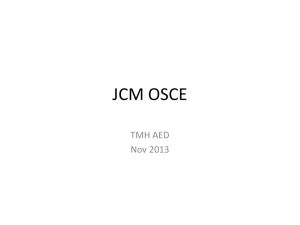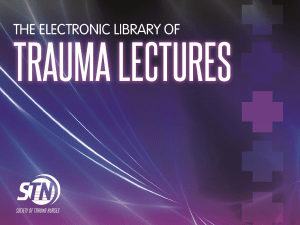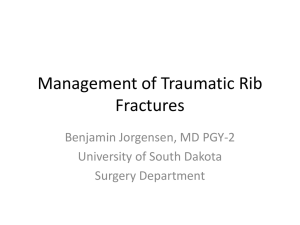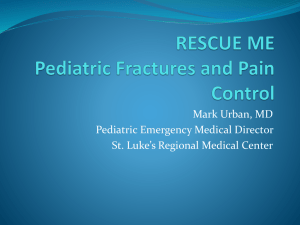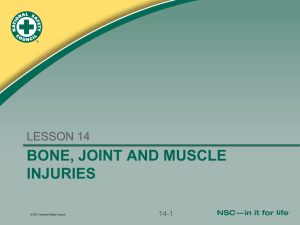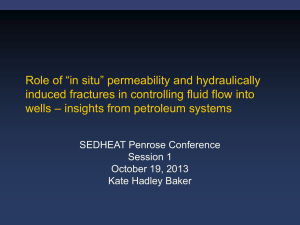Resident Talk - Skeletal Trauma
advertisement
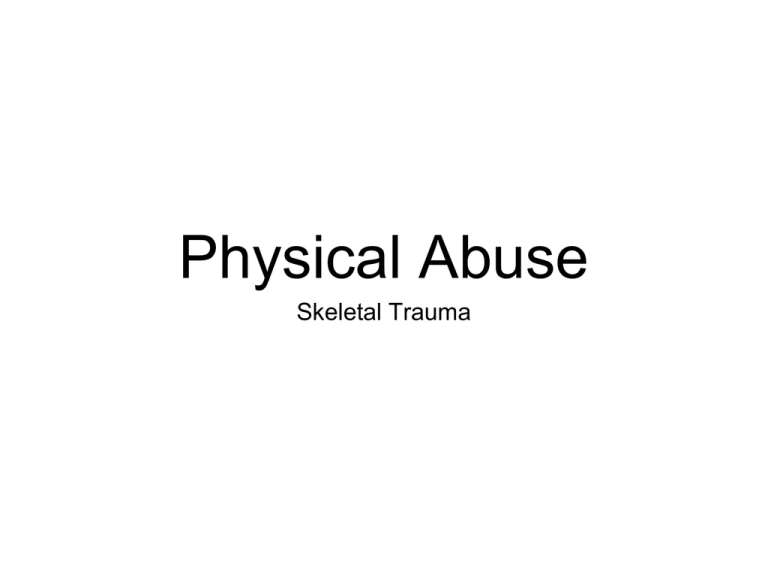
Physical Abuse Skeletal Trauma Case 1 • 3 year old boy with cerebral palsy GMFCS IV, wakes up and noted to have pain and irritability with manipulation of the right arm. He is non-verbal but reliably vocalizes indicators of his emotional state. No previous fractures. On Valproic Acid for generalized seizures. • Seen in an ED and Dx with comminuted proximal right humeral #. Treated with sling, referred to orthopaedics. • No history of trauma. Had one of his occasional generalized tonic seizures in the middle of the night. Mom and boyfriend assert that the fracture must have happened during the seizure. • Mineral content of bone appears slightly reduced. Lab studies initiated. Home with Mom. • 2 days later, presents to ED again. Reportedly woke up with right thigh deformity and pain with manipulation of the leg. • Found to have mid-shaft spiral femoral fracture. • Skeletal survey reveals old, healing fracture of proximal left humerus. Mom does not recall trauma to this area or any history of symptoms. • Subsequently determined to have no evidence of bone fragility. • No further fractures in 18 months while living with bio-dad and grandmother. Case 2 • 4 month old healthy, term infant, living with mom and boyfriend. • Seen for vomiting and poor feeding. History of unexplained arm bruising and bleeding from the mouth (for which he had been seen and D/C from hospital). • Upper GI done for GERD(?) and multiple healing rib fractures noted. • Skeletal survey shows multiple metaphyseal fractures, vertebral compression fractures and a scapular fracture. • Otherwise normal exam and thorough work-up. • No history of accidental trauma except for when 3 year old cousin squeezed his chest. Epidemiology of Abusive Fractures • Found in up to 1/3 of children investigated for physical abuse. • 80% of inflicted fractures occur in children < 18 months (55-70% in infants < 1) • 2% of accidental # occur in this age group • Occult and/multifocal # occur almost exclusively in this age group. Epidemiology • Significant association between multiple fractures and abuse. • Worlock found 74% of abused children with fractures had multiple fractures. 16% in non-abused. Fractures - General Truths • In most cases, pain, swelling/deformity, change in use of limb is apparent to outside observers. • Some subtle fractures (buckle fractures) are very stable and cause minimal symptoms • Preverbal children may just be fussy or cry with handling. • Usually don’t have overlying bruising. Skeletal Survey • For all children less than 24 months where physical abuse and sometimes severe neglect are suspected. • Sometimes in older children with severe injuries or if motor development is less than 24 months (such as children with cerebral palsy • Most commonly identify occult rib, metaphyseal fractures but also skull, vertebral and other less common fractures. • Often identify occult healing fractures COMPLETE SKELETAL SURVEY TABLE APPENDICULAR SKELETON Humeri (AP) Forearms (AP) Hands (PA) Femurs (AP) Lower legs (AP) Feet (AP) AXIAL SKELETON Thorax (AP, lateral, right and left obliques), to include ribs, thoracic and upper lumbar spine Pelvis (AP), to include the mid lumbar spine Lumbosacral spine (lateral) Cervical spine (lateral) Skull (frontal and lateral) Skeletal Survey • Overall, about 15-25% of skeletal surveys pick up occult fractures, especially in infants (< 1 year old) • Should be repeated in 2 weeks in most cases. 1525% of second surveys reveal fractures not apparent on the initial study. Bone Scan • Helpful to pick up rib fractures before there is visible healing on plain films. • Unhelpful for metaphyseal fractures due to tracer uptake in the physes. • May require sedation. • Sometimes used if initial SS negative, but a high risk case when you can’t wait 2 weeks for the follow-up survey. The Skull • Very common fracture in both accidental and inflicted trauma. • Can occur as a result of accidental short (<2-3 feet) falls in infants, toddlers and older children • Typically simple, linear fractures, sometimes with surprisingly little swelling/bruising. Skull Fractures- Worrisome features • Unwitnessed/no explanation in a non-mobile child • Degree of injury inconsistent with reported mechanism. • Depressed or comminuted • Multiple sites of fracture • Crosses suture lines Long Bone Fractures • Most common accidental fractures • Often seen in inflicted injury as well • Mechanism of injury can be estimated from type of fracture • spiral fracture - torsion/twisting • transverse fracture - bending • buckle fracture - compression Clavicle • Common accidental injury from fall onto shoulder or outstretched arm. • Common birth injury. Often not diagnosed at the time • Not a common inflicted fracture but certainly can be. Humerus and Radius/Ulna • Very common accidental fracture in toddlers and older children. • Most accidental humeral fractures are from falls and result in supracondylar fractures. • Proximal humeral fractures in younger children may be more suspicious unless there’s a good story. Forearm Fractures • Accidental fractures of one or both forearm bones happen very often, usually from falls. • Usually transverse or buckle fractures. • Be suspicious if the appearance of the fracture doesn’t fit with the story. eg. spiral fracture from a straight fall Hands/Feet • Overall uncommon in young children. Really rare in toddlers, even from falls. • Much more common in older children. • Very suspicious in young children/infants without a good accidental story. Femur and Tibia/Fibula • Again, highly suspicious in a non-weight bearing child. • Simple spiral fractures of the shafts of the tibia or femur can occur (tibia more commonly) from simple falls, twists and other seemingly innocuous trauma in toddlers (Tibial ones are called “Toddler’s Fractures”). Metaphyseal Fractures In infants and young children, the metaphysis is an area of transition between cartilage and new bone. Metaphyseal Fractures During torsional or shearing forces, fractures can occur along the area of transition. Metaphyseal Fractures • These fractures are seen mostly in infants and are almost always a result of inflicted trauma. • Require type and degree of force which does not occur during day to day handling or typical household accidents. Accidental Metaphyseal Fractures • Roll-over car crashes when arms are flailing around. • Sometimes during birth when the arm comes out first and the doctor has to pull on it to deliver the rest of the baby. • Forceful manipulation during serial casting for clubfoot Ribs • Very cartilaginous, so they are quite compressible and flexible. • Very large amounts of energy are required to break a child’s rib(s), especially an infant • If accidental, it has to be a significant and dramatic event. • In other words, someone has to know what happened. Rib Fractures Very hard to see until some healing occurs Accidental causes of rib fractures: • High speed motor vehicle collisions • High falls (not household falls) • Chest compressions during CPR • Rarely, during a very traumatic vaginal birth Inflicted Rib Fractures • Usually multiple, but not always • Posterior (paraspinal) from compression/squeezing • Lateral/Anterior: From compression or direct impact Some uncommon but very concerning fractures These are considered inflicted unless a major accidental trauma has occurred: • vertebral • sternum • scapula • pelvis Yes Doctor, but how old is that fracture? • X-ray appearance does not allow for much precision. • Initial healing can be seen in 4-10 days • New bone (callus) formation in 11-21 days • Hard callus appears 19-28 days • Metaphyseal and skull fractures are even harder to date. Assessing for Bone Fragility as a Contributor • History of previous fractures, significant prematurity, risk for nutritional deficiency, previous/current illnesses/medical conditions, medications (steroids, anti-convulsants) • Family history of fractures • Physical exam - Growth and development, features of OI - blue sclera ,triangular face, bowing of the legs once ambulatory Assessing for Bone Fragility Plain Films • • • • bone mineral content signs of rickets wormian bones (OI) evidence of other rare bone diseases Bone Mineral Density • • • Few good standards for infants and young children. Norms are specific to anatomic location, technique and equipment used. No known correlation between a particular Z-score and fracture risk is unknown. Lab tests • • CBC, electrolytes, alkaline phosphatase, phosphate, vitamin D, parathyroid hormone, calcium, magnesium, albumin, renal function, liver function, serum copper. Urinalysis, urine calcium/creatinine ratio depending on results of bloodwork and films. Often the best indicator that the child does not have bone fragility is the absence of fractures when in a safe environment. Bone Diseases Metabolic Bone Disease of Prematurity • Greater risk if BW<1500g, complicated TPN history, generally sicker and smaller. • Can be impaired bone mineral content or frank rickets. Rickets • A radiologic diagnosis. If the bones don’t show rickets, the child doesn’t have rickets. • Does not correlate with serum vitamin D levels. • Occurs when osteoid in growth plates fails to mineralize (osteomalacia) • Multiple causes (prematurity, renal, nutritional) Bone diseases Osteoporosis Secondary to Systemic Illness/Treatment • Chronic lack of weight bearing - neuromuscular disease • Chronic glucocorticoid use • methotrexate, some anticonvulsants • renal, liver diseases • Intestinal malabsorption • Endocrine disorders - hyper-thyroid/parathyroid, Cushing’s Osteogenesis Imperfecta (OI) • Rare genetic disorder (2-4/100,000 births) affecting collagen • Col-1A1 or Col-1A2 genes. Different forms have different inheritance. • Multiple types, some cause severe fractures at birth, or prenatal/newborn demise • Types I and IV are milder and can cause easy fractures in seemingly healthy infants OI Types I and IV • Usually have other findings such as blue sclerae, bowing of the legs, abnormal X-rays, short stature, hearing loss. • Diagnosed by clinical findings and mutation analysis. • Rib and metaphyseal fractures (CML) in these types of OI are less common. • OI is 25-50X rarer than physical abuse. Other bone diseases that you can rule out with a clinical exam • Copper deficiency • Menke’s disease • Lots of other rare stuff The Work-up • Not every suspicious fracture needs a metabolic bone work-up. • Usually reserved for multiple or occult fractures. • Especially important if fractures are the only abnormality found on the work-up i.e. no bruises, head injury etc

